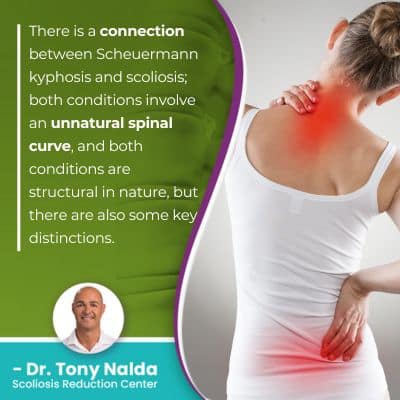Scheuermanns Kyphosis: Diagnosis and Treatment Options

The spine's natural and healthy curves make it stronger, more flexible, and better able to handle mechanical stress; these curves can vary in size from person to person, and as long as they fall within a healthy range, this is normal, but if a patient's level of thoracic kyphosis falls beyond a normal range, it can become problematic.
There are a number of spinal conditions that cause a loss of the spine's healthy curves. In kyphosis, the thoracic spine's outward-bending spinal curve becomes excessive, and Scheuermann's kyphosis is structural so needs to be impacted on a structural level with treatment.
The spine's main sections have different curvature types, and this is the difference between lordosis and kyphosis.
Table of Contents
The Spine's Healthy Curves
A healthy spine is curved at each of its main sections: the cervical spine (neck), the thoracic spine , and the lumbar spine.
It's the spine's natural curves that give it an 'S' shape when viewed from either side and make it appear straight when viewed from the front and/or back.
The spine's curves help to absorb mechanical stress during movement and make the spine more flexible with a wider range of motion.
Each spinal section has a characteristic curvature type, and the cervical and lumbar spinal sections have lordotic curves, while the thoracic spine features a kyphotic curve.
Lordosis versus Kyphosis
Lordosis refers to spinal curves that bend inwards, towards the body's center in a standard 'C' shape, and kyphosis refers to a spinal curve bending backwards, away from the body's center.
While it's normal for people's curvature sizes to vary, if a person's level of lordosis or kyphosis becomes under- or over-pronounced, the curve size becomes problematic, and the biomechanics of the spine are disrupted.
A healthy range of cervical lordosis is between 20 and 40 degrees, while a healthy range of lumbar lordosis would fall between 20 and 60 degrees.
A healthy range of thoracic kyphosis would fall between 20 and 40 degrees.
Kyphosis is a term that can be used interchangeably to refer to both healthy and unhealthy levels of kyphosis, along with hyperkyphosis.
Excessive kyphosis means the thoracic spine is unnaturally curved outwards, and this is also known as roundback because of the postural changes associated with a rounded-forward upper back and shoulders.
Now, there are also different types of kyphosis, but before exploring additional types of kyphosis, let's explore Scheuermann's kyphosis.
What is Scheuermann's Kyphosis?
Scheuermann's kyphosis is a structural condition that involves a structural abnormality within the spine (malformed vertebrae) so treatment has to, first and foremost, impact it on a structural level.
 Scheuermann's kyphosis is commonly diagnosed at 50+ degrees, and the curve will be rigid and most visible when in a forward bending position; at least 3 adjacent vertebral bodies will have a 5-degree wedge per vertebra, with small disc herniation called Schmorl's nodes.
Scheuermann's kyphosis is commonly diagnosed at 50+ degrees, and the curve will be rigid and most visible when in a forward bending position; at least 3 adjacent vertebral bodies will have a 5-degree wedge per vertebra, with small disc herniation called Schmorl's nodes.
The condition most often develops during adolescence and gets worse with growth; symptoms can include a pitched-forward posture, pain, and fatigue, and it's important to understand that unlike postural kyphosis, because it's structural, no change in position will reduce the size of the kyphotic deformity.
So Scheuermann kyphosis is more complex to treat than postural kyphosis.
Although rare, a potential complication of severe Scheuermann kyphosis is lung impairment that can develop as curves become more severe and encroach on space used by the lungs.
Spinal abnormalities that develop in utero can be familial, meaning if one person has been diagnosed in the family, it's considered a risk factor for others, and height and weight are considered contributing factors to the condition's development.
The abnormality in how the spinal vertebrae grow and develop can be familial, meaning it runs in families, and it’s also thought that height and weight can be contributing factors.
Scheuermann's Kyphosis and Scoliosis
 There is a connection between Scheuermann kyphosis and scoliosis; both conditions involve an unnatural spinal curve, and both conditions are structural in nature, but there are also some key distinctions.
There is a connection between Scheuermann kyphosis and scoliosis; both conditions involve an unnatural spinal curve, and both conditions are structural in nature, but there are also some key distinctions.
A scoliotic curve bends unnaturally to the side and twists, while an excessive kyphotic curve bends excessively forward causing a pitched-forward appearance that looks like heavy slouching.
It's more accurate to say that kyphosis and scoliosis can occur together than it is to say one contributes to the onset of the other.
Scoliosis affects the spine on a coronal plane (front to back), and kyphosis impacts the spine's sagittal vertical axis (side to side).
Kyphotic curves are more rigid so they don't progress as quickly as scoliosis, in many cases, although kyphosis is also known to get worse over time, and the etiology of both conditions isn't fully understood.
When it comes to treatment, both can benefit from a proactive conservative chiropractic-centered treatment approach that works towards realigning the spine on a structural level and also increasing core strength through physical therapy so posture is improved, along with the spine's surrounding muscle strength; strong back muscles means the spine is optimally supported and stabilized.
Postural Kyphosis
Postural kyphosis is the most common type, and this type is also the simplest to treat because the condition is postural, not structural.
When a spinal condition is structural, it means it involves an abnormality within the spine itself, whereas spinal conditions that are postural don't involve any structural issues, they are more how the body is held and how body positioning is affecting the muscles.
In postural spinal conditions, there is no structural abnormality with the spine, and the condition is more about posture, body positioning, and the way chronic poor posture can affect the muscles that support and stabilize the spine.
So in structural conditions, no change in position will impact the spine's unnatural curve, but in postural conditions, changes to how the spine is positioned will also impact its curves; for example, for those with excessive levels of postural kyphosis, standing with the back against the wall and making an active effort to flatten the shoulders against the wall while pushing the chest outwards will actually change the level of kyphosis back to within a healthy range.
Postural kyphosis can develop at any age, but most commonly appears during adolescence when excessive slouching and poor posture are common.
Congenital Kyphosis
Congenital kyphosis is structural because it involves a malformed spine that develops in utero, so babies are born with the condition.
In cases of congenital kyphosis, bones of the spine (vertebrae) are misshapen in some way that causes the spine to form with excessive levels of kyphosis; in many cases, the bones are more triangular in shape, and they should be rectangular so the spine can't form in a straight and neutral alignment.
When vertebrae are more triangular in shape, they tend to wedge forward (anterior wedging), causing an excessive kyphotic curve, and these cases can be severe and need invasive treatment to realign the spine.
Infants and children born with congenital scoliosis often present with additional abnormalities so need to be comprehensively assessed.
Conclusion
While the cause of scheuermann kyphosis remains undetermined, we know it's commonly diagnosed during adolescence and tends to get worse with growth and time.
Scheuermann kyphosis dorsalis juvenilis makes a juvenile's spine develop an excessive level of kyphosis, most often affecting the middle/upper back as the thoracic spine.
Even in spinal conditions that aren't considered progressive, they tend to get worse over time because the spine, like the rest of the body, is subject to natural age-related degenerative changes.
Spinal degeneration most often starts with its intervertebral discs; this can cause one or more disc(s) to become desiccated and change shape as a result, and this can affect the position of nearby vertebrae as adjacent vertebral bodies attach to the disc in between; degenerative disc disease is a contributing factor in the development of a number of spinal conditions
Patients with scheuermann's disease have to be proactive, and the first step of treatment is determining the type so its underlying cause and/or nature can be addressed.
Postural kyphosis is the most common type, and it's the simplest to treat because it's a nonstructural spinal condition, meaning it's caused by chronic poor posture, and when active effort is made to adjust the position of the body and spine, the unnatural curvature can be reduced.
Cases of congenital scoliosis are also complex to treat because they are caused by a malformed spine that develops in utero so also involve a structural abnormality within the spine itself.
A patient's level of thoracic kyphosis should fall within a healthy range, but once the thoracic spine's curvature size exceeds 40 degrees, the curve size is becoming excessive and problematic, and the mot common symptom is a postural change that causes a pitched-forward posture where the upper back and shoulders are excessively rounded forward.
Dr. Tony Nalda
DOCTOR OF CHIROPRACTIC
After receiving an undergraduate degree in psychology and his Doctorate of Chiropractic from Life University, Dr. Nalda settled in Celebration, Florida and proceeded to build one of Central Florida’s most successful chiropractic clinics.
His experience with patients suffering from scoliosis, and the confusion and frustration they faced, led him to seek a specialty in scoliosis care. In 2006 he completed his Intensive Care Certification from CLEAR Institute, a leading scoliosis educational and certification center.
About Dr. Tony Nalda
 Ready to explore scoliosis treatment? Contact Us Now
Ready to explore scoliosis treatment? Contact Us Now





